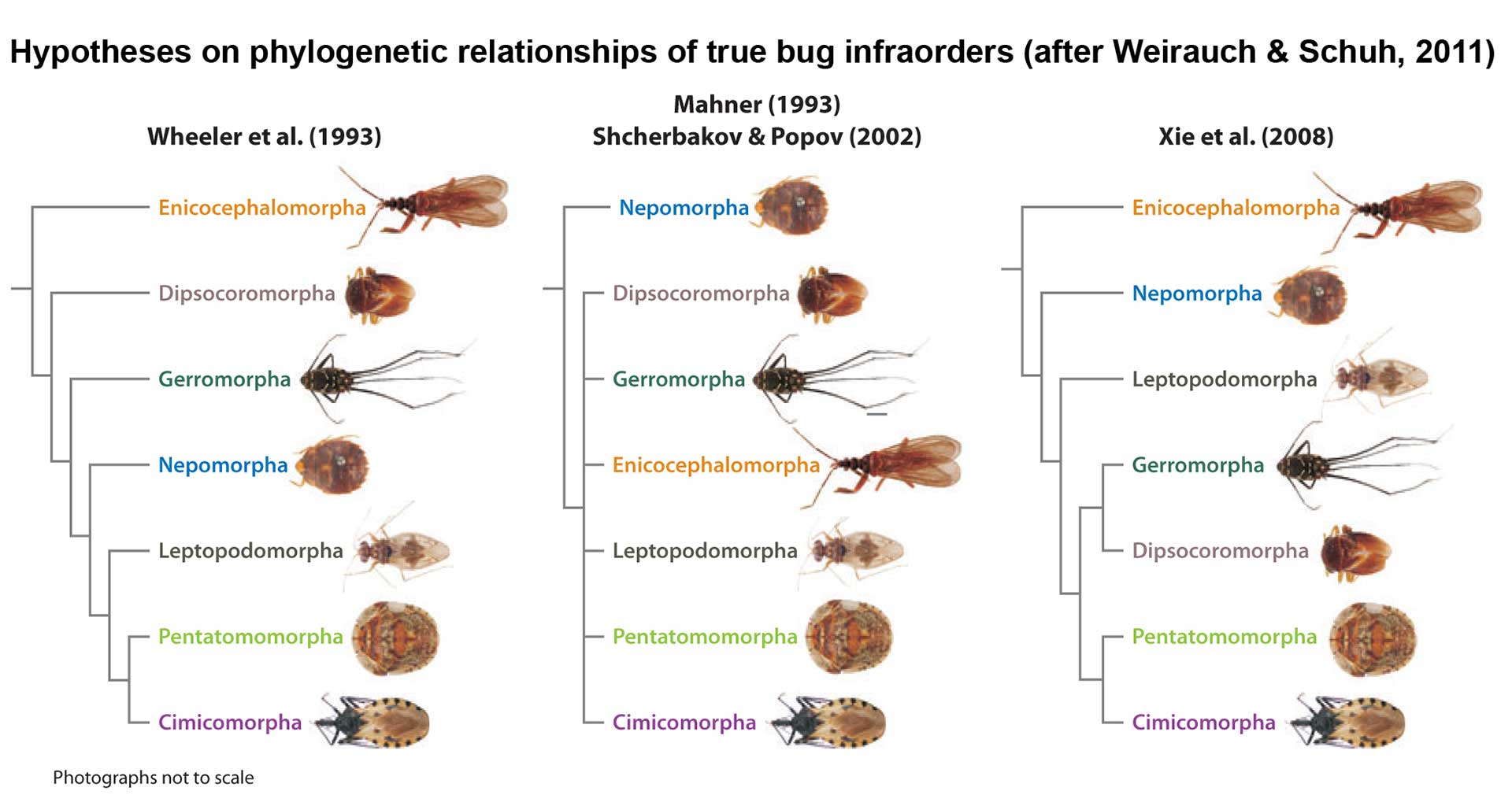Higher-level Systematics of Heteroptera
Background
Heteroptera, the true bugs, are part of the largest clade of non-holometabolous insects, the Hemiptera, and include more than 45,000 described species. They comprise agricultural pests, e.g., Pentatomidae (stink bugs) and Miridae (plant bugs), nuisance pests such as Cimicidae (bed bugs), natural enemies used in biological control applications e.g., Anthocoridae (minute pirate bugs) and some Reduviidae (mostly Harpactorinae), and blood-feeders that are of medical importance as vectors of Chagas disease (Triatominae). Heteroptera also contain species that possess fascinating evolutionary traits that provide textbook examples for sexual selection, e.g. water striders (Gerridae), and for sexual conflict involving traumatic insemination (e.g., bed bugs and allies).
Phylogenetic hypotheses are important for understanding heteropteran diversity and essential for testing current classifications and evolutionary hypotheses. Heteropteran phylogenetics has made progress during the past two decades in analyzing relationships among the 7 infraorders of true bugs (see some of the hypotheses above; after Weirauch and Schuh, 2011), but also those within infraorders and certain families. Recent publications (Johnson et al. 2018, Kieran et al. 2018, Weirauch et al. 2019, De Moya et al. 2019) have corroborated relationships within the Geoheteroptera (Leptopodomorpha + Cimicomorpha + Pentatomomorpha) and have shown that Dipsocoromorpha, Enicocephalomorpha, and Gerromorpha form a clade, the DEG clade. It is still unclear if that DEG clade or Nepomorpha are the earliest diverging lineage within Heteroptera.
References
Grazia, J., Schuh, R.T., Wheeler, W.C., 2008. Phylogenetic relationships of family groups in Pentatomoidea based on morphology and DNA sequences (Insecta: Heteroptera). Cladistics 24, 932–976.
Jung, S., Lee, S., 2011. Molecular phylogeny of the plant bugs (Heteroptera: Miridae) and the evolution of feeding habits. Cladistics 28, 50–79.
Li, M., Tian, Y., Zhao, Y., Bu, W., 2012. Higher Level Phylogeny and the First Divergence Time Estimation of Heteroptera (Insecta: Hemiptera) Based on Multiple Genes. PLoS ONE 7, e32152.
Schuh, R.T., Slater, J.A., 1995. True bugs of the world (Hemiptera: Heteroptera): classification and natural history, in: True Bugs of the World. Comstock Publishing Associates, Cornell University Press, pp. i–xii, 1–336.
Schuh, R.T., Weirauch, C., Wheeler, W.C., 2009. Phylogenetic relationships within the Cimicomorpha (Hemiptera: Heteroptera): a total-evidence analysis. Systematic Entomology 34, 15–48.
Weirauch, C., Schuh, R.T., 2011. Systematics and evolution of Heteroptera: 25 years of progress. Annual Review of Entomology 56, 487–510
Johnson, K. P., Dietrich, C. H., Friedrich, F., Beutel, R., Wipfler, B., Peters, R. S., Allen, J., Petersen, M., Donath, A., Walden, K. K. O., Kozlov, A., Podsiadlowski, L., Mayer, C., Meusemann, K., Vasilikopoulos, A., Waterhouse, R., Cameron, S., Weirauch, C., Swanson, D., Percy, D., Hardy, N., Terry, I., Liu, S., Zhou, S., Misof, B., Robertson, H. M., Yoshizawa, K. 2018. Phylogenomics and the evolutionary history of hemipteroid insects. Proc Natl Acad Sci USA 115:12775–12780. doi: 10.1073/pnas.1815820115.
Kieran, T. J., Forthman, M., Gordon, E., Hoey-Chamberlain, R., Kimball, R., Faircloth, B. C., Weirauch, C., Glenn, T. C. 2019. Insight from an ultraconserved element bait set designed for hemipteran phylogenetics integrated with genomic resources. Molecular Phylogenetics and Evolution 130: 297–303. https://doi.org/10.1016/j.ympev.2018.10.026
Weirauch, C., Schuh, R. T., Cassis, G. and Wheeler, W. C. 2019. Revisiting habitat and lifestyle transitions in Heteroptera (Insecta: Hemiptera): insights from a combined morphological and molecular phylogeny. Cladistics 35: 67–105. DOI: 10.1111/cla.12233
De Moya, R., Weirauch, C., Sweet, A. D., Skinner, R., Walden, K. K. O., Swanson, D. R., Dietrich, C., and Johnson, K. 2019. Deep instability in the phylogenetic backbone of Heteroptera is only partly overcome by transcriptome-based phylogenomics. Insect Systematics and Diversity 3 November 2019, 7. https://doi.org/10.1093/isd/ixz020
